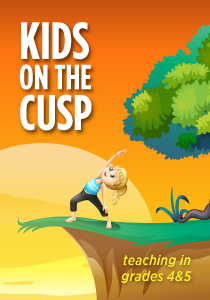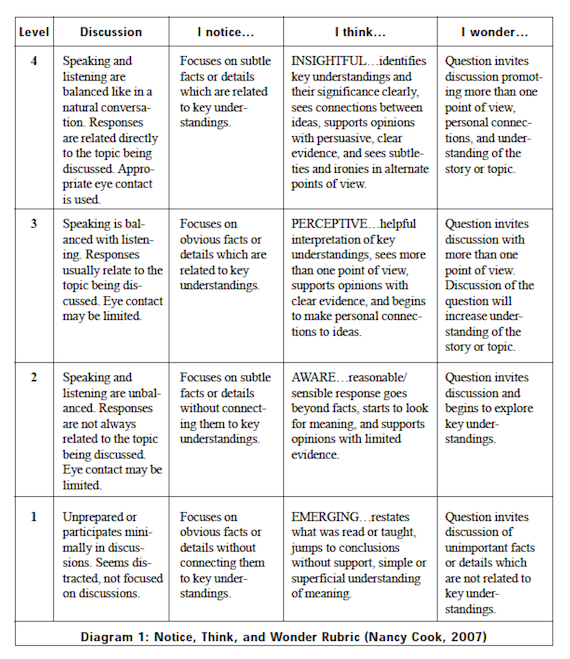Monkeying Around with a Rubric for the Rest of Us
A MiddleWeb Blog

When I saw my daughter’s Hot Shots basketball competition on the calendar, my heart gave a quick blip. It was going to be held the following Wednesday.
My heart may have blipped, but it never questioned what I needed to do. My principal, Joe, respects my work ethic, so there was no anxiety when I walked into his office to let him know.
Here’s the thing: Leaving ten minutes early to attend my 10-year old daughter’s basketball competition doesn’t affect my principal’s view of my teaching ability. But it will affect my rating in the new teacher evaluation program developed by Kim Marshall.
The “Highly Effective” Level 4 in the Marshall plan’s attendance category – Has perfect or near perfect attendance (98-100%) – is unattainable in the real world. I live in the real world (most of the time). To earn a four, there can be no family emergencies or basketball competitions. I have come to terms with the fact that I am “a three” in this area (95-97%). I wouldn’t have it any other way.
Requesting Imperfection
My principal respects me. He respects my teaching. He knows I am at school quite early several days a week. He knows this because he’s there too.
“Mornin’ Joe. What are we today? An eight? A nine?”
“Seven and a half,” he responds, turning his swivel chair away from his computer screen to face me.

“The only thing you need to do is complete a staff survey about the Marshall Plan,” he recalls, looking up. “It’s on Survey Monkey.”
I chuckled. “Can I just print out the six articles I wrote for MiddleWeb critiquing the plan?”
There was a pregnant pause. Then, it was his turn to chuckle a bit. “That would be pretty thorough, but I need you to take this survey too.”
One Attaboy on the Survey Monkey
Back in the fall, Marshall’s rubric was a source of angst for many weeks, as I picked the verbiage apart, domain by domain, word by word, absolute by absolute. It did, however, make me think about my teaching, notice what my strengths and weaknesses were, and engage the critical thinking portion of my brain.
In the Survey Monkey invitation for feedback, I did comment on one valuable component of the plan. Observers can pop into your classroom any time without any notice…or time to prepare a snazzy lesson for the benefit of the observer.
Unscheduled observations give a more accurate picture of the teacher in his natural habitat. They allow for a more accurate reflection of classroom life. I’m for that.
A Realistic Rubric for Students and Teachers
Classroom life was alive and well on Thursday morning, when my class arrived with questions:
“How did Meghan do in the basketball thing?”
“Did Meghan win?”
“How’d she shoot?”
My students genuinely take an interest in my life. I take an interest in theirs too. One of my goals as an educator is to help children think about how the world works. I want to help them explore deeper, more critical connections, and develop sympathy and empathy for others.
How do we assess this in them? How do we assess this in ourselves? Where is the rubric to help us identify these life goals?
I haven’t found all the answers just yet, but I came across a rubric that I think will help. The more I look at it, the more I can see its active and effective application in assessing a student’s level of deep thinking across the content areas, regardless of curriculum content. And I can also apply it to my teaching, to my level of “thinking awareness” as an educator.
Nancy Cook and Michael Fisher discuss this thought-provoking rubric in an article, “Notice, Think, and Wonder: New Pathways to Engage Critical Thinking,” as Fisher recalls here. According to the pair, the rubric is “a tool to help students and teachers visualize the level of critical thinking” that is going on in the classroom.
The rubric created by Cook and Fisher is my kinda’ rubric. Assessing levels of critical thinking is difficult. We can ask our students (in true Marshall-like fashion) to always be highly engaged in every lesson at all times. We can ask, but we are asking the impossible.
Fisher and Cook’s goal is “to find a way to meet students where they need to be, involve technology, and increase their level of critical thinking” in the classroom. These are my current goals. A rubric that really assesses what I want to assess, that helps me focus my particular flavor of subjectivity, is a tool I need so that I can implement some changes in my classroom.
The duo’s rubric does just that, as it focuses on assessing a student’s level of discussion. I consider discussion to be anything in oral or written form (performance art is encouraged, as well.) It asks them to communicate their thoughts and ideas with each other. And Fisher and Cook’s rubric contains no absolutes. It identifies levels of understanding. It asks students to be aware of their thinking, of what they “notice, think, and wonder.”
[Editor’s note: When we contacted Mike Fisher about sharing the rubric, he not only graciously agreed but noted an updated title that (serendipitously) reflects Mary’s thinking. “I modified it to Notice, Think, Wonder, and Extend,” he says, “so that teachers could collect their observations and then share them with each other. The rubric itself was originally meant for leading high quality discussions, but it’s morphed into being a good rubric for…social interactions about learning. I’ve written more about it here.”]
Another Exercise in Rubric Frustration
I don’t believe Marshall’s attendance rubric allows for any teacher to be deemed worthy of a Level 4 rating, signifying “Highly Effective” teaching. I might have already blown that by going to my daughter’s basketball competition (she had a blast and sank a coupla’ three pointers…all sixty-two pounds of her!).
A friend and colleague e-mailed me a recap of important dates from the missed faculty meeting. We have statewide testing in about a month and school supply orders for next year have appeared on the agenda. Our spring concerts are in full swing and the district art show is coming up.

I like when the rubric matches the goal. I am frustrated and disheartened by much of the message in Marshall’s rubrics. I don’t want to go back and visit it again, but it’s state-mandated that I do.
When you set an unattainable goal for your teachers (or your learners), it’s destined to have a negative impact.
On this next visit to Marshall’s seemingly inaccessible world of teaching perfection, I’m going to try to keep it in perspective. I can strive for many of these absolutes, but I doubt I can reach them. Perhaps the focus shouldn’t be on Marshall’s numeric rating this time around. Instead, I am going to focus on what I notice, think, and wonder, as I go through the process once again.





































I was at an international school that followed the Marshall rubric. What a horrible experience.
I had some horrible moments of frustration too, but it sure got me thinking!…
Wow, Mary! Just wow! You’ve hit the nail on the head here both with the use of our rubric and with the rubrics states are using for teacher evaluation. The through line is not a journey toward perfection; it’s a journey toward improvement. I’m thinking now that our performance levels shouldn’t have been numbers but rather descriptive categories like emergent or novice or professional or proficient. To be honest, I like the teacher evaluation rubrics that are out there, but I don’t like the fact that they are used to divine a percentage of effectiveness for a teacher–that’s ludicrous–but it’s easy to quantify hence it is being used in that way. Also, ALL rubrics should be works in progress rather than absolutes on anything. That begs the question of what’s beyond the absolute? I enjoyed reading your blog post and love that the idea of Notice, Think, and Wonder is still resonating. Thank you for sharing your perspective! -Mike
Thanks, Mike…for the kind words AND the rubric you and Nancy developed!…I am enjoying looking at my learners with a clearer focus. I must say, there are many pieces of Marshall’s rubric that I found valuable, but the absolutes were tarnishing my view of the plan’s merits for a while…and their use in quantifying teaching…I read your piece linked above too…So you want students “to have rich literary experiences that feed their souls for the rest of their lives but also teach them to be evaluative thinkers and questioners of the status quo”?…that sounds like an excellent objective to me!…
I am not familiar with the Marshall rubric and I hope it doesn’t cross my path based on your post!
There were actually a few benefits to taking a look, but I’m still not a big fan…it’s now part of my job description…hope you don’t encounter the same types of absolutes in your evaluations, too!
I am left wondering how learning style and personality preferences play into what we deep “advanced.” As an N-Intuitive in Myer’s Briggs, I LOVE and gravitate to finding significance, connection and broader meaning. Then again, I’m also an OD professional, hence a system’s thinker. But not everyone is built that way, including teachers and, more importantly, students, so definitions of “success” could look very different and a rubric developed by someone with a different personality preference might view other cognitive and analytical skills, and other “intelligences,” as more “advanced.” Just food for thought.
The word advanced is quite subjective, too. I will have to check out Myer’s Briggs. I am not familiar with it, but I always enjoy investigating different learning styles and ways to assess…thanks, Veronica. I will look into it!
I appreciate the conclusion you reach at the end. I completely understand the need for rubrics, but at the same time, they should be guidelines not absolutes. Wondering is a great solution; I wish you a lot of wonder.
Thank you!…and I wish you the same!
How awesome is that statement? “I wish you a lot of wonder.” That should be a mantra in every classroom! -Mike